Dive Details
Location
Date
Sunday 13 January 2019
Time
12:14pm - 1:44pm
Buddy
Sheree Rose
Seas
Slight
Visibility
10 to 15 metres
Duration
90 minutes
Surface interval
Maximum depth
21.9 m
Average depth
15.8 m
Water temperature
21.1°C
Dive Profile from Citizen Hyper Aqualand

Tides at Botany Bay AEDT
Note that tides at dive site may vary from above location.
High
1:59am
1.30m
Low
7:38am
0.70m
High
1:48pm
1.44m
Low
8:29pm
0.52m
Details
Sheree joined me for my second dive today. I tried to talk her into going to The Monument to see the mating red-fingered anglerfish but she had her heart set on The Leap so that's where we went.
Sheree jumped in from the shelf but it was calm enough for me to get in from the low platform. The water was running over it but the waves were small. We swam out on the surface before descending. We swam at around 60° towards the sand line and ended up just to the south-east of Pygmy Rock. The visibility was 10 to 15 metres, there was barely any surge or current and the water temperature was around 21°C. I was tempted to have a look at Pygmy Rock but we had a lot of ground to cover and I wanted to have a good look in the Field of Pygmies.
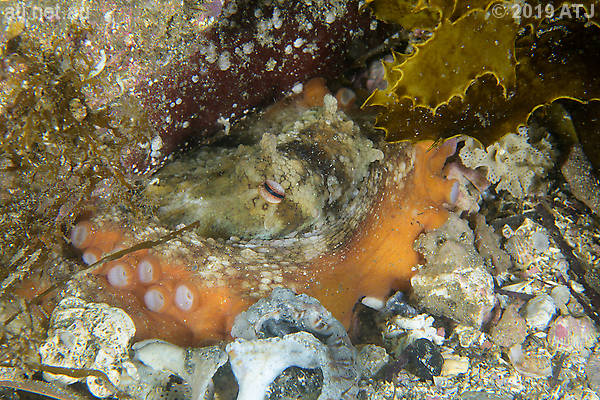
Common Sydney Octopus, Octopus tetricus. 21.7 m.
We swam past Pygmy Rock and on to the first rock with known pygmies in Field of Pygmies. I found the original female pygmy (IL2018110201) first as she was near where I saw her yesterday. I pointed her out to Sheree. I then spotted her partner (IL2018110202) and I also pointed him out. I swam to the other end of the rock and found the male (IL2018110301) behind the red sponge. I found the female (IL2018110302) on the other side of the grey sponge. I pointed them out to Sheree.
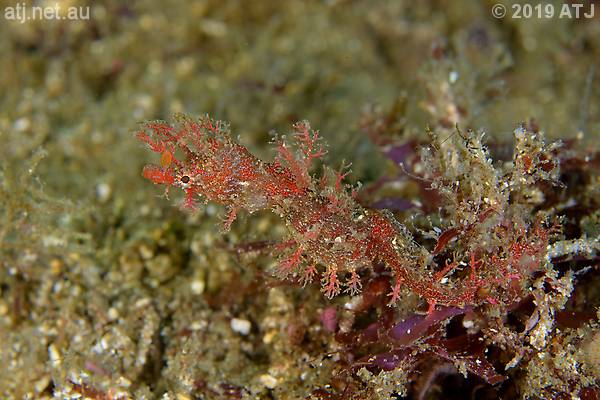
Female Sydney Pygmy Pipehorse, Idiotropiscis lumnitzeri, (IL2018110201). 21.1 m.
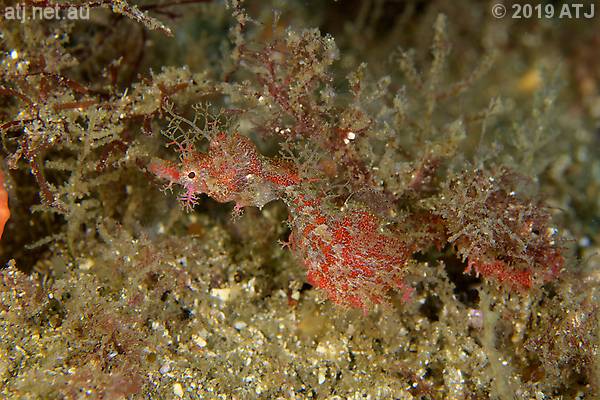
Male Sydney Pygmy Pipehorse, Idiotropiscis lumnitzeri, (IL2018110202). 21 m.

Male Sydney Pygmy Pipehorse, Idiotropiscis lumnitzeri, (IL2018110301). 21 m.

Female Sydney Pygmy Pipehorse, Idiotropiscis lumnitzeri, (IL2018110302). 21.1 m.
I headed over to the rock closest the sand line to look for Matt's male and his partner. I'd seen them both yesterday but I was not able to find either of them today. I probably could have found them eventually but we needed to keep moving.
I found the cryptic male (IL2018121101) on his rock just on from the first rock. I looked for his partner but could not find her.
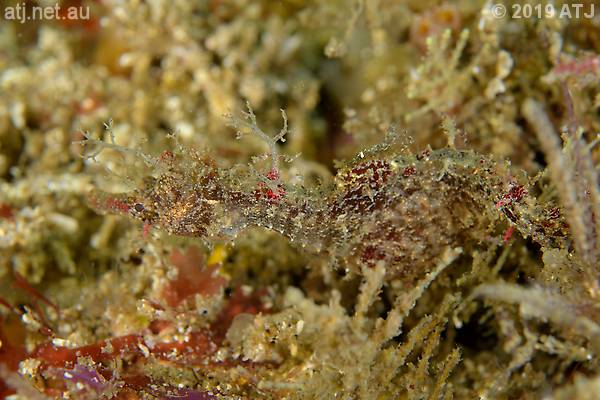
Male Sydney Pygmy Pipehorse, Idiotropiscis lumnitzeri, (IL2018121101). 21.4 m.
Sheree was swimming over the rock with a lot of sponges where I have seen a tiny juvenile (IL2018122603) in the past so I went to look for it and found it. I pointed out out to Sheree.

Juvenile Sydney Pygmy Pipehorse, Idiotropiscis lumnitzeri, (IL2018122603). 20.1 m.
I swam on to the rock just before Bob & Lucy Rock and looked for the small female I have seen there. I couldn't find her but I did find a small male (IL2019011301). I looked around for the female but could not find her.
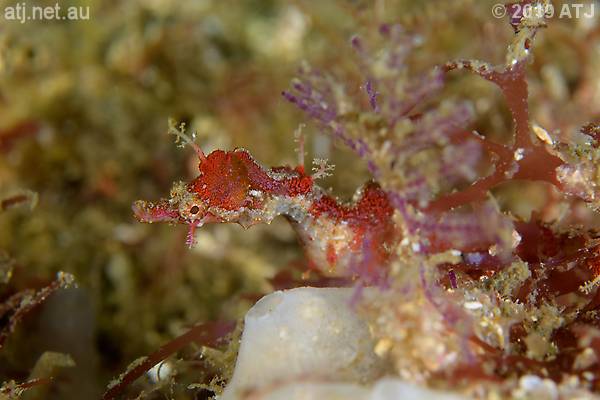
Male Sydney Pygmy Pipehorse, Idiotropiscis lumnitzeri, (IL2019011301). 20.7 m.
We headed to Bob & Lucy Rock. I found the red male (IL2018110204) straight away and then the female (IL2018110203) not far away. I had a bit of a look for the juvenile but did not see it.
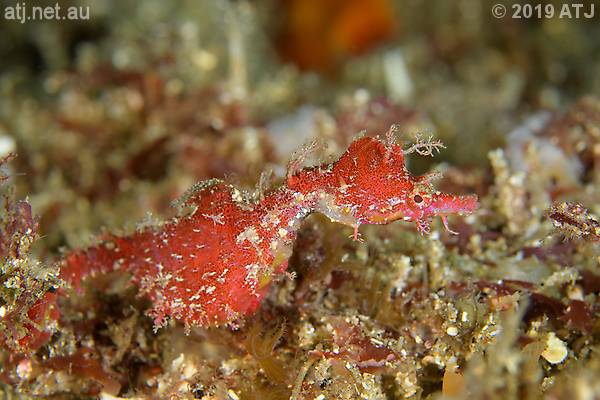
Male Sydney Pygmy Pipehorse, Idiotropiscis lumnitzeri, (IL2018110204). 20.5 m.
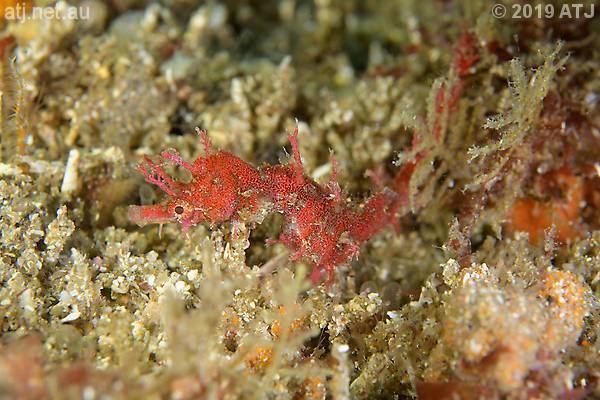
Female Sydney Pygmy Pipehorse, Idiotropiscis lumnitzeri, (IL2018110203). 20.5 m.
We continued along the sand line. My next planned stop we Ian's Pygmy Rock but on the way Sheree spotted the small weedy seadragon that Nick had spotted yesterday with the clingfish. The clingfish was gone.

Weedy Seadragon, Phyllopteryx taeniolatus. 21.4 m.
At Ian's Pygmy Rock I spotted the pink male (IL2018122302) and the grey female (IL2018122301). I looked on the adjacent rock and found the dull red male (IL2018120101). I looked for his partner but could not see him. I pointed them out to Sheree.
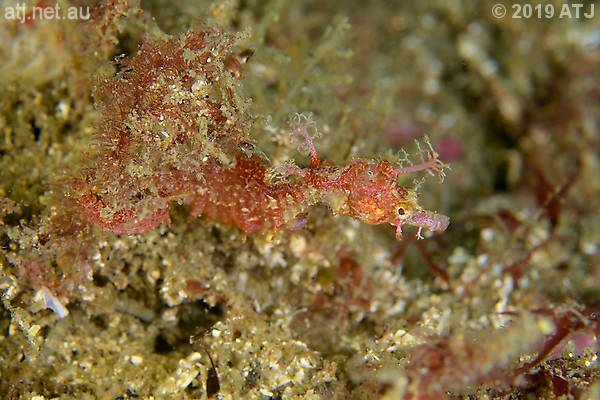
Male Sydney Pygmy Pipehorse, Idiotropiscis lumnitzeri, (IL2018122302). 20.8 m.
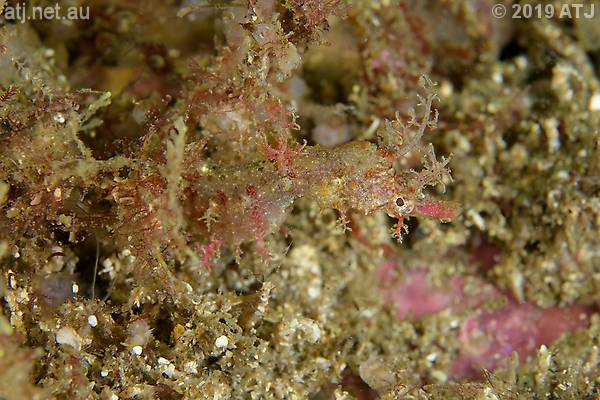
Female Sydney Pygmy Pipehorse, Idiotropiscis lumnitzeri, (IL2018122301). 21 m.
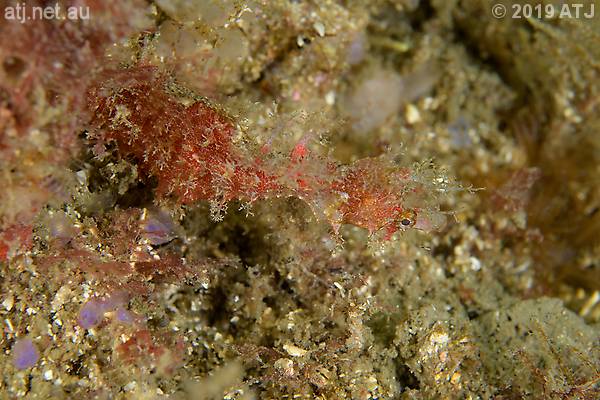
Male Sydney Pygmy Pipehorse, Idiotropiscis lumnitzeri, (IL2018120101). 20.7 m.
As we were heading towards Seahorse Rock, Sheree spotted "Clyde", the male weedy seadragon. He was on the sand. He still doesn't have any eggs. I haven't seen him with eggs at all this season. What is amazing is that I saw him in Seadragon Alley yesterday and now he's south-east of Seahorse Rock. That's a long way to travel in a day.
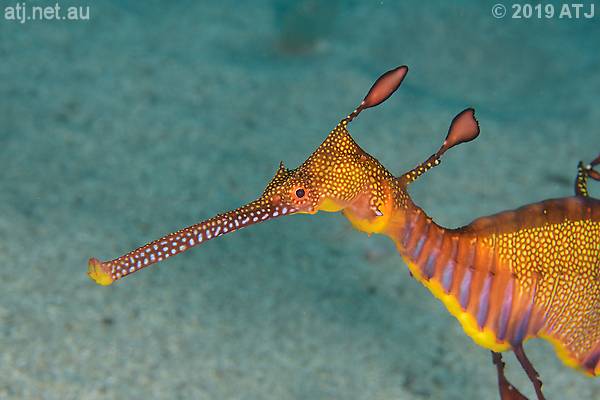
Weedy Seadragon, Phyllopteryx taeniolatus, ("Clyde"). 21.1 m.
We swam past Seahorse Rock and on to the flat rocks with sponges. I looked under the overhang as I went through but there were no weedies there. I spotted the male weedy with eggs in the gap between the rocks but before I got there Sheree pointed out a female weedy I'd swum past. I photographed her and the male with eggs. Another weedy swam by and headed towards the overhang.

Weedy Seadragon, Phyllopteryx taeniolatus. 20.1 m.
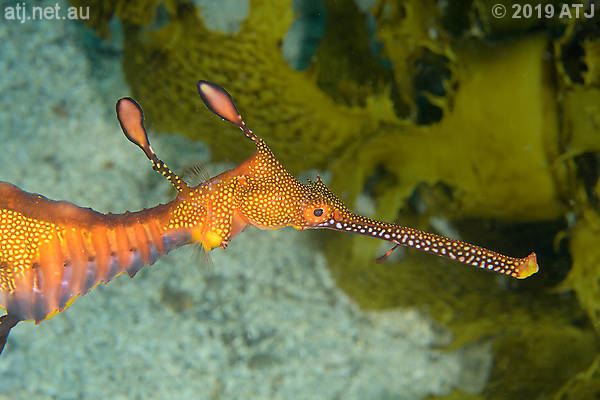
Weedy Seadragon, Phyllopteryx taeniolatus. 19.9 m.
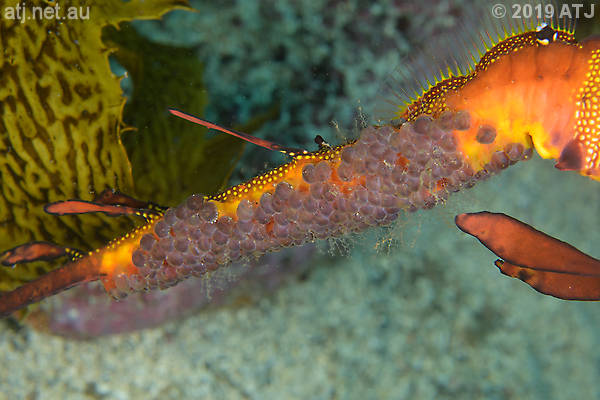
Eggs on the tail of a male Weedy Seadragon, Phyllopteryx taeniolatus. 19.9 m.
I swam up to the rocks above the weedies to look for the pygmy pipehorses. I found the pink female (IL2018080102) and the pink male (IL2018080101) in their usual algae. I looked for the other pair but could only find the male (IL2018092903).
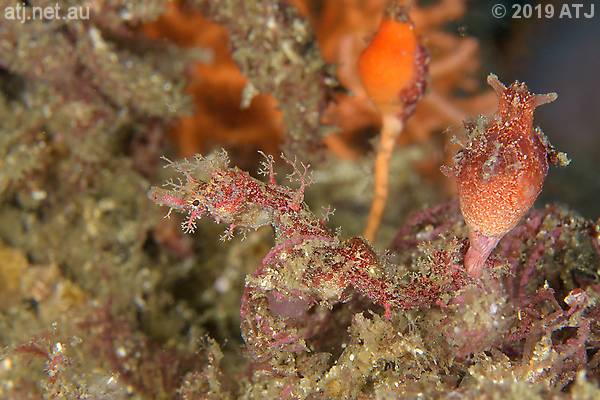
Female Sydney Pygmy Pipehorse, Idiotropiscis lumnitzeri, (IL2018080102). 18.1 m.

Male Sydney Pygmy Pipehorse, Idiotropiscis lumnitzeri, (IL2018080101). 18.2 m.

Male Sydney Pygmy Pipehorse, Idiotropiscis lumnitzeri, (IL2018092903). 18.7 m.
Sheree had gone on a head so I swam quickly over the higher rocks to Southern Cross Rock. She was over the next rock. We swam into Seadragon Alley. We hadn't gone far when Sheree spotted the juvenile weedy seadragon who is really quite large now. She also spotted a small wobbegong.
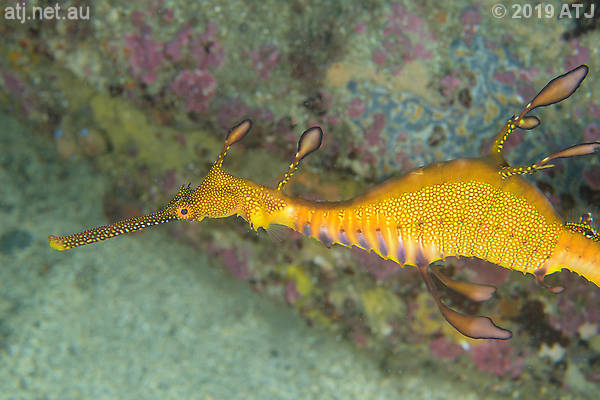
Weedy Seadragon, Phyllopteryx taeniolatus. 17.8 m.
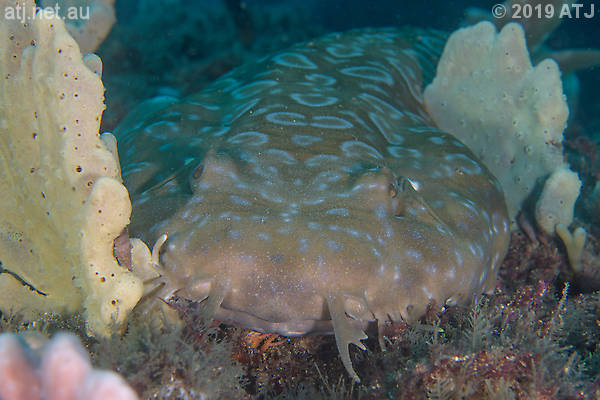
Spotted Wobbegong, Orectolobus maculatus. 17.7 m.
We swam out of Seadragon Alley and up the slope towards Big Rock. I was hoping to spot the small orange red-fingered anglerfish I'd seen yesterday. I didn't remember the exact location but I knew the past I took so if it hadn't moved I'd find it. Fortunately, it was still in the same spot.
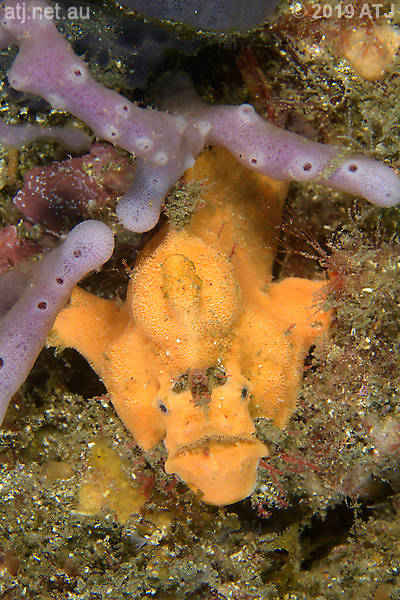
Red-Fingered Anglerfish, Porophryne erythrodactylus. 13.7 m.
We swam on to Big Rock. I looked for two pygmy pipehorses than Ron had found 9 days ago and found them both (IL2019010401, IL2019010402). I showed them to Sheree.

Male Sydney Pygmy Pipehorse, Idiotropiscis lumnitzeri, (IL2019010401). 13.4 m.
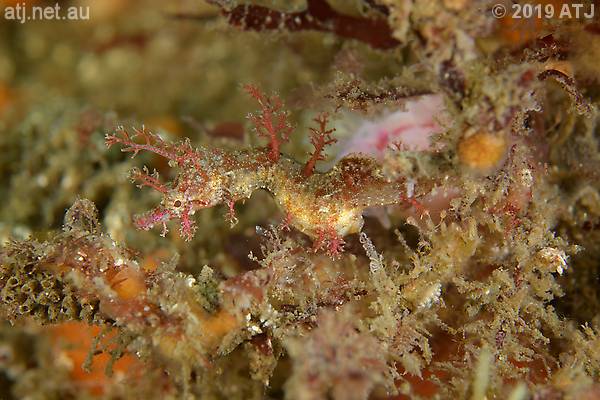
Female Sydney Pygmy Pipehorse, Idiotropiscis lumnitzeri, (IL2019010402). 13.3 m.
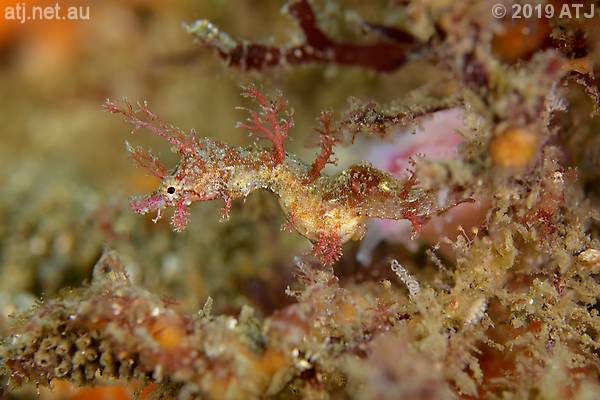
Female Sydney Pygmy Pipehorse, Idiotropiscis lumnitzeri, (IL2019010402). 13.4 m.
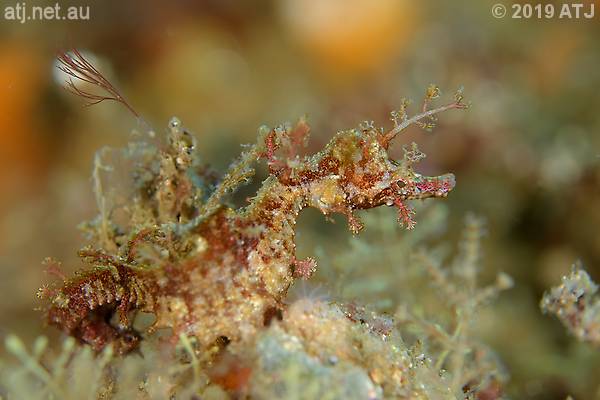
Male Sydney Pygmy Pipehorse, Idiotropiscis lumnitzeri, (IL2019010401). 13.4 m.
I headed over to the base of the rock below Hand Rock. I found the male pygmy (IL2018111001) but could not find the female or the juvenile. Again, I didn't have time to properly look. I swam up to Hand Rock and spotted the juvenile (IL2018122401) there.

Male Sydney Pygmy Pipehorse, Idiotropiscis lumnitzeri, (IL2018111001). 14.5 m.
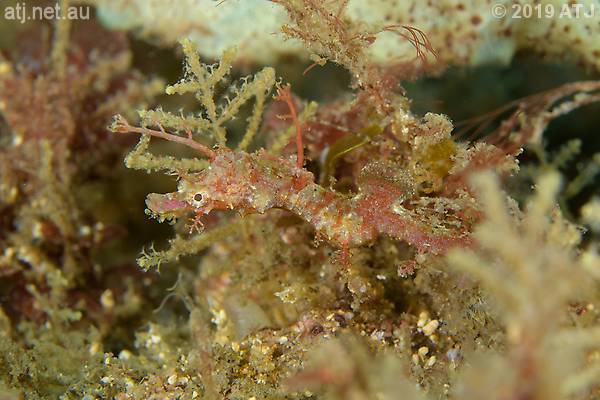
Juvenile Sydney Pygmy Pipehorse, Idiotropiscis lumnitzeri, (IL2018122401). 13.6 m.
We headed along the reef. I found the male weedy seadragon in the kelp below Diversity Rock. He no longer has eggs but is staying in the same area.
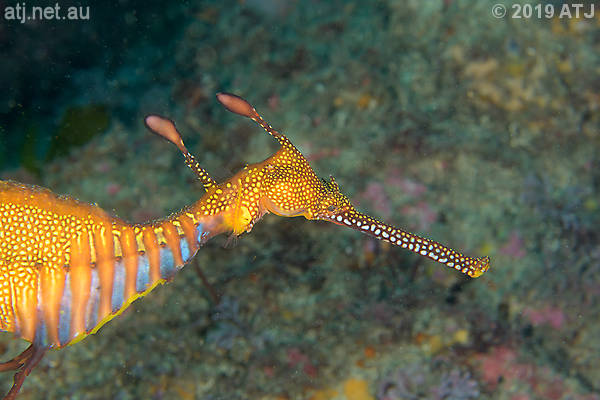
Weedy Seadragon, Phyllopteryx taeniolatus. 14 m.
We swam up to the basket star before heading along to Little Big Rock. The large yellow red-fingered anglerfish was in its usual place on one of the rocks behind Little Big Rock. I looked for "Petra", the white pot-bellied seahorse but she wasn't where she had been on the previous dive. I looked around the rocks but could not see her. Sheree was down to 50 bar so we had to move on without finding her.
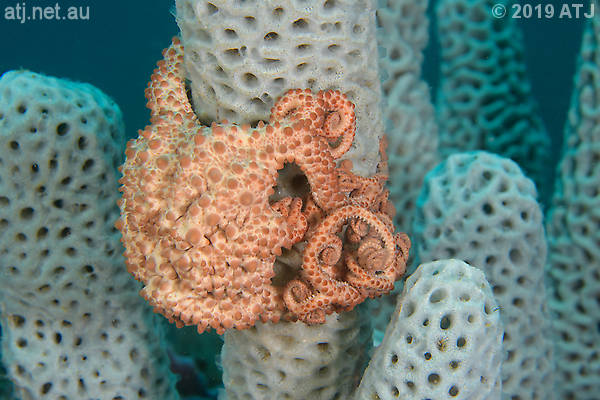
Basket Star, Astrosierra amblyconus. 12.2m.
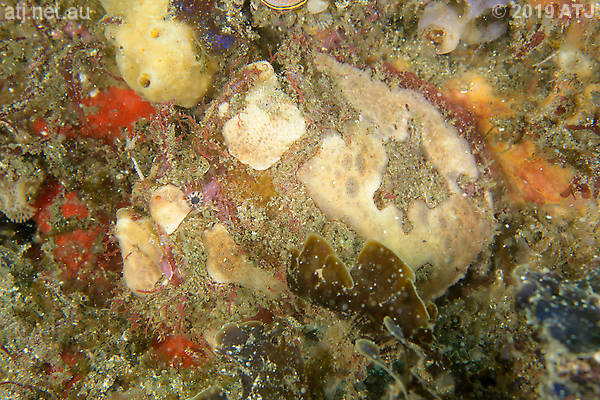
Red-Fingered Anglerfish, Porophryne erythrodactylus. 12.7 m.
We swam quickly along the sand line. I didn't look for the pipefishes and continued to the rock where "Jodi", the orange pot-bellied seahorse, has been. I had a quick look for her before dropping down to the small orange red-fingered anglerfish. I took a few photographs and then we headed for the exit.

Red-Fingered Anglerfish, Porophryne erythrodactylus. 12.2 m.
We ascended to Split Rock and did our safety stops before swimming underwater to the exit. The exit was easy.
Camera gear
Camera
Nikon D500
Lens
Nikon AF-S Micro Nikkor 60mm f/2.8G ED
Housing
Ikelite 6812.5
Lens port
Ikelite Flat Port 5502.41
Strobe
2 x Ikelite SubStrobe DS161